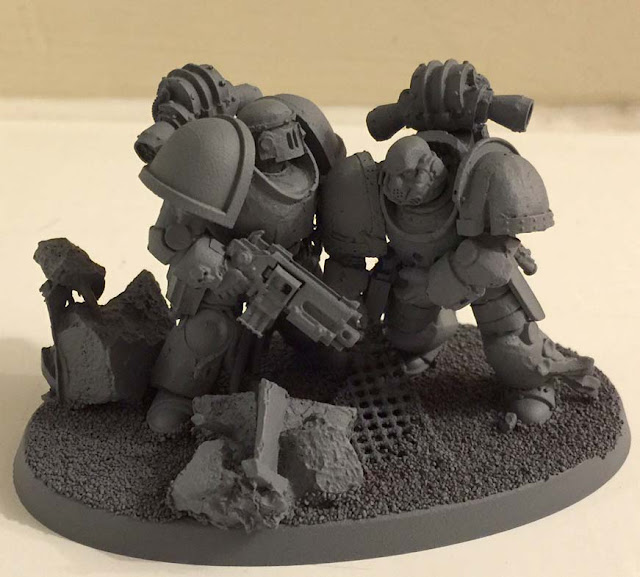+ Purefinder Chanterwick +
 |
| Imperial Fist soldiers oversee construction. |
+ Purefynderre Chaunterwycke +
+ Wherein the deck ys stacket +
Finding his place, he began tracing a finger through the uneven pages of the old history.
"The style is a little florid, I'm afraid, but that was the accepted style –" the underscribe stopped as he saw Northgrass' eyebrow rise and mouth set sternly. "Perhaps another time." He coughed, and began:
'Lamplit and now largely derelict, the settlement of Purefinder Chanterwick has, like most of the City, served many purposes over drawn-out centuries. Of its origins, none can be sure, for histories have been written of its histories; and much now is lost that might once have been remembered. '"
"'For now, it suffices that it sits between the docks and the leathermaker's district; and on a thoroughfare that connects more important parts of the city to one another. A fairly anonymous area, it encapsulates the lot of the Imperial peon. This is the domain of the Purefinders, a vital part of the leatherman's art; for it is they who gather the nuisances used in 'bate'; an infusion of fecal matter from animal species used to soften hides for tanning. The transit of equids, riding-dogs and cavalieravans as they pass through means that much of the road is filled with – unpleasant – giftings of these riding and draft beasts.'"
Having finished reading out the extract, Ferlinghetti closed the book slowly. The old leather cover sat awkwardly on the yellowed and buckled pages. Veck smiled inwardly as the underscribe placed the book down slowly and unconsciously wiped his metallic fingers on his robe.
The Inquisitor rose to his feet.
"So, dwellings in the dung district, Ferlinghetti? You've come up in the world." He said, wryly. "Unglamorous, under the web. Why, Manderghast'll make an agent of you yet.'
+ As well as being fun to write, making up a story about the location necessarily makes it a bit more personal – much like making up a name for your general. It will also start sparking ideas. Here, for example, the idea of the area sitting on the outskirts of the leathermaker's district might spark some ideas for shopfronts; the sort of rubbish that'll be scattered about, and so forth. I like the idea of stringing up some washing lines, too – purefinders probably like a good scrub! +
+ Practical: paving +
+ With the roads in place and board dry, I took it outside to get rid of any stray bits of glue or sand using a scraper. +
+ A few minutes work left me with the bare streets +
+ I then began the process of paving the streets, following this tutorial [+noospheric link embedded+] from Rob Hawkins' Hobby Blog. To add a little extra detail, I decided to add some manhole covers, which are made from small decorative wooden bits from Hobbycraft. These were glued in place first, aligned with one another. +
+ I then began gluing on the paving slabs, placing a couple of larger ones and building up the shapes around and between them. +
+ I gradually began filling in the gaps with smaller pieces. In hindsight, I wish I'd made them all a little smaller to enhance the sense of scale (these are fairly huge at 28mm/32mm), but I think it works quite nicely. +
+ A couple of hours – and a couple of cups of tea – later, it was starting to look a bit more developed. You'll notice that I've added smaller stones around the manhole covers. This has a practical purpose (covering the area around a cirle), but also looks much prettier. +
+ Here's the board at the end of the evening. The bulk of the roads are done, though I now need to go back add fill in some spaces with smaller stones. I'll leave a few gaps for broken or missing slabs, but I hope the addition of tinier stones will help sell the scale. The picture above also shows the pavement started on the lower side (bottom of the picture). For this, I glued stones of varied size along a line, roughly 5mm (¼in) away from the gutter. I'll fill this line with kerb stones, and fill the space behind the main slabs with smaller cobbles. +
+ I couldn't resist playing with toy soldiers at this point, so I'm going to pretend that this shot is to demonstrate the different levels and show the scale. The marine on the left is standing in the gutter, and the second on the pavement step. While only 25mm wide, you can see that a 30mm base still sits steadily on it. When the paving is added to the pavement, the drop will be even less. The sergeant (with the banner) is on the pediment. As you can see, there's a nice height difference between the different levels. +
+ A slightly arty shot of the streets, this also shows one of the buildings on its own base. Again, this base gives some extra levels and height. I don't think this will cause much in-game effect, but it'll improve the realism of game photographs, and add to the sense of immersion. +
+ A closer (if very dark!) look at the building across the road. +
























































